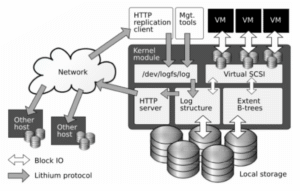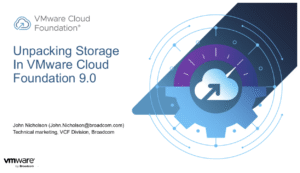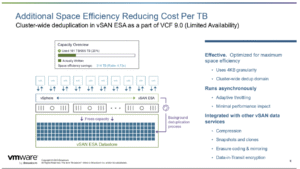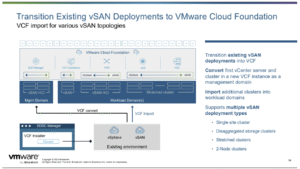
VCF 9.0 was released in mid-June and one important component in that portfolio is the storage stack. VMware’s built-in storage solution VCF 9.0 had a new release of vSAN which we are going to explore further following TFD’s session on this topic.
Since the early days of Project Lithium being revealed in 2010, the release of vSAN in 2013, and until today, it has been a steadily evolving system. It has always been designed to be robust and self-healing. During this process, VMware even bought the company Virsto to get access to developers with deep storage knowledge, and some were expecting technology such as the Log-Structured File System to find its way into vSAN, but only tiny pieces here and there were used.
When vSAN was released, there were some initial quirks where several disk controllers didn’t live up to their expectations. There was also some initial pain while we were waiting for Avago to release new firmware. Yes, that’s the same Avago that later acquired some important tech companies, including Broadcom, Symantec, CA, and VMware.
I attended the first vSAN training session in Europe and was an early adopter of enabling vSAN in production environments as soon as certified hardware became available in the fall of 2014. These issues were solved within a few months, and some of the early customers had to buy new disk controllers. Now, in 8.0U3, we are 20 on-disk format revisions later, we see that vSAN is still evolving version by version.
vSAN initially had a 4KB block size, which is quite good for deduplication. This did, however, change to 8KB, which was better for performance but worse for deduplication.
When vSAN Express Storage Architecture (ESA) was released in vSAN 7, it was a big architectural change. The Original Storage Architecture (OSA) was built at a time where spinning disks were the norm, and solid-state disks were still quite expensive. Even though we’ve had support for vSAN All Flash (AFA) since 2015, that support was still built around the same architecture as for spinning disks. When ESA was introduced in vSAN 8 in 2022, it was a huge step in the right direction. It even came with a Log-Structured File System, but it was not the one from Virsto: It was one VMware filed a patent for. It supports only NVMe disks and is built specifically to take advantage of that hardware architecture. It did, however, come with a few caveats as it didn’t support all of the features of the old architecture, as it only had compression but no support for deduplication.
Would our dreams and hopes come true with vSAN in VCF 9.0?
At TFD’s session on this subject, we were lucky to have John Nicholson as our presenter. He has been working with vSAN for many years and has deep knowledge of the subject. He showed us several new and important improvements to the vSAN portfolio in version 9:
- VCF 9.0 – Storage Operations: This includes new dashboards to monitor storage powering VMware Cloud Foundation, providing holistic at-a-glance conditions across multiple clusters and retrieving key metrics and health information from vSAN APIs.
- Global Deduplication: Now per cluster instead of per disk group.
- vSAN 9.0: Offers improved performance and security for vSAN storage clusters.
- Multi-Site Operations: Optimized VCF Operation consoles for vSAN monitoring and holistic monitoring and management.
- vSAN File Services Improvements: Support for up to 500 file shares per cluster, beneficial for cloud-native workloads, NFS/SMB shares for guest VMs, and legacy physical servers.
- vSAN-to-vSAN Replication: Provides agile, high-performance per-VM replication to remote vSAN clusters, with replication as frequent as 1 minute. This is part of VMware Live Recovery (VLR).
- Stretched vSAN Simplified Site Maintenance: Easily place an entire site into maintenance mode with a single click in the UI, maintaining availability of powered-on VMs and ensuring data consistency. It also includes extensive prechecks and automated workflows.
- Self-Service Recovery for Sustained Dual-Site Outage: Manual site takeover for vSAN stretched clusters to regain site availability after a severe outage, even upon simultaneous failure of data site and witness site.
- Disaggregated Storage Clusters: Provides flexibility to power your data center, from HCI to disaggregated storage using vSAN ESA.
The block size is now 4KB again, which is good news for deduplication. What’s even more exciting is that deduplication is now per cluster instead of per disk group. This combination, for the initial version (Limited Availability), is promising up to 8x space reduction compared to 2x in OSA. Yes, it will of course depend on the data and workload, but this is a huge and welcome step forward. This feature still has limitations: it’s available for vSAN 9.0 P01 (as part of VCF 9.0) with approved requests, cluster sizes between 3 and 16 hosts, and telemetry (CEIP) enabled. It is currently limited to standard single-site clusters with networking using 25Gb or higher, and does not yet support vSAN 2-Node clusters or vSAN data-at-rest encryption enabled. These limitations are likely in place to gather more insight into usage and how to better improve such new functionality.
The ability to import existing vCenter deployments into VCF using VCF Operations is good news for vSphere customers suddenly owning VCF licenses. This allows for the transition of existing vSAN deployments into VCF, converting the first vCenter server and cluster into a new VCF instance as a management domain, and importing additional clusters into workload domains.
VCF 9.0 continues to support traditional storage systems using NFS, iSCSI, FCoE and FC. One new feature is that it now supports stretched workload domains with traditional metrocluster storage even if the management domain isn’t stretched. Note that If you’re using vSAN, the management domain still needs stretching.
One thing that wasn’t mentioned in this presentation, but I think it’s worth noting: Virtual Volumes. Even if it shares a lot of concepts with vSAN I guess its adoption rate has been low. It was recently announced that it’s deprecated from VCF version 9.
It’s clear that vSAN, especially with the advancements in VCF 9.0, continues to evolve into a premier storage solution for VMware Cloud Foundation. Monitoring it is still split between VCF Operations and the vSphere client so that’s probably something for the future.
vSAN builds on the trust users have placed in the hypervisor for workload management, extending that to storage with unprecedented levels of control, visibility, and protection at the VM level. The continuous innovation in areas like global deduplication, enhanced data protection, and improved multi-site operations demonstrates Broadcom/VMware’s commitment to making vSAN an even more robust, efficient, and flexible platform for modern data centers.
The VMware Cloud Foundation 9.0 Showcase: Powering the Modern Private Cloud was presented by VMware in association with Techstrong and Tech Field Day. The videos will be posted to the Tech Field Day YouTube channel and on the website. You can learn more about VMware Cloud Foundation 9.0 on the VMware website.





